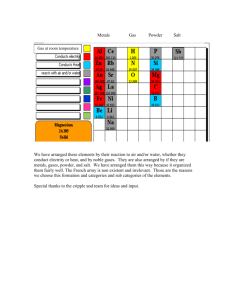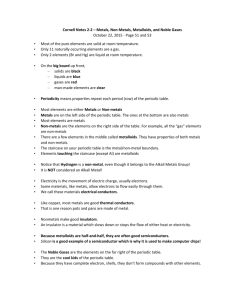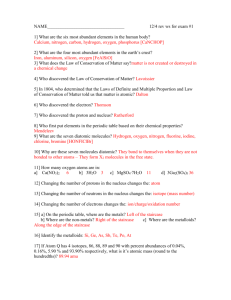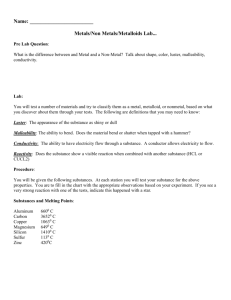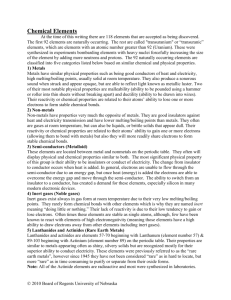Periodic Table of the Elements
advertisement
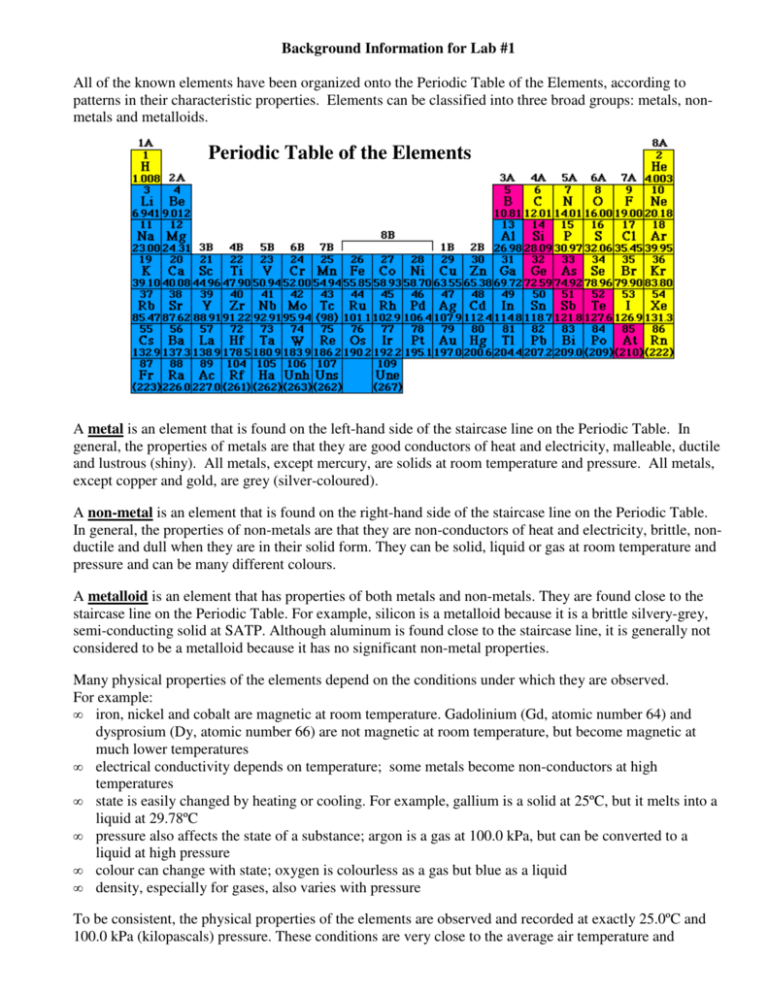
Background Information for Lab #1 All of the known elements have been organized onto the Periodic Table of the Elements, according to patterns in their characteristic properties. Elements can be classified into three broad groups: metals, nonmetals and metalloids. Periodic Table of the Elements A metal is an element that is found on the left-hand side of the staircase line on the Periodic Table. In general, the properties of metals are that they are good conductors of heat and electricity, malleable, ductile and lustrous (shiny). All metals, except mercury, are solids at room temperature and pressure. All metals, except copper and gold, are grey (silver-coloured). A non-metal is an element that is found on the right-hand side of the staircase line on the Periodic Table. In general, the properties of non-metals are that they are non-conductors of heat and electricity, brittle, nonductile and dull when they are in their solid form. They can be solid, liquid or gas at room temperature and pressure and can be many different colours. A metalloid is an element that has properties of both metals and non-metals. They are found close to the staircase line on the Periodic Table. For example, silicon is a metalloid because it is a brittle silvery-grey, semi-conducting solid at SATP. Although aluminum is found close to the staircase line, it is generally not considered to be a metalloid because it has no significant non-metal properties. Many physical properties of the elements depend on the conditions under which they are observed. For example: • iron, nickel and cobalt are magnetic at room temperature. Gadolinium (Gd, atomic number 64) and dysprosium (Dy, atomic number 66) are not magnetic at room temperature, but become magnetic at much lower temperatures • electrical conductivity depends on temperature; some metals become non-conductors at high temperatures • state is easily changed by heating or cooling. For example, gallium is a solid at 25ºC, but it melts into a liquid at 29.78ºC • pressure also affects the state of a substance; argon is a gas at 100.0 kPa, but can be converted to a liquid at high pressure • colour can change with state; oxygen is colourless as a gas but blue as a liquid • density, especially for gases, also varies with pressure To be consistent, the physical properties of the elements are observed and recorded at exactly 25.0ºC and 100.0 kPa (kilopascals) pressure. These conditions are very close to the average air temperature and pressure in most labs or classrooms so they are referred to as the "Standard Ambient” conditions of Temperature and Pressure, and abbreviated as SATP. Because the state of a substance is so dependent on temperature and pressure, when recording the state of a substance, you should always specify “solid at SATP, liquid at SATP or gas at SATP” so people know that your observations were made under normal room conditions. The Gaseous Elements Many elements are clear, colourless, odourless gases at SATP. They have very low densities, so their densities are reported in g/L while the densities of the solid elements are reported in g/cm3. For example, oxygen has a density of 1.429 g/L. This means that one litre (1000 cm3 or 1000 mL) of oxygen gas at standard conditions has a mass of 1.429 grams. For comparison, solid magnesium has a density of 1.74 g/cm3 which means that 1 cm3 of magnesium has a mass of 1.74 g. The gaseous elements can be easily distinguished from one another using their chemical properties. ♦ hydrogen gas (H2) is a combustible gas. It burns rapidly (explodes) when it reacts with the oxygen in air, producing the characteristic “pop” noise when a flaming splint is introduced. ♦ oxygen gas (O2) is not combustible; that is, oxygen gas does not burn. However oxygen gas supports combustion, which means that it will cause other substances to burn vigorously. This is why a glowing splint re-lights when it is introduced into oxygen gas. The wooden splint burns, the oxygen does not. ♦ nitrogen gas (N2) and the Noble gases (He, Ne, Ar, Kr, Xe and Rn) are not combustible, nor do they support combustion (help other substances to burn). These gases are chemically un-reactive or inert. They cause a flaming or glowing splint to go out soundlessly. These un-reactive gases can be used as fire extinguishing agents to protect precious or expensive items like bank records or art. If fire is detected, the room is flooded with an inert gas which dilutes the oxygen in the air and puts out the fire.

